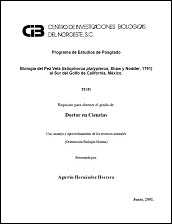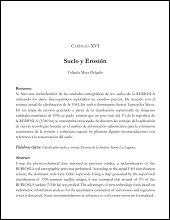Ecología térmica y uso de microhábitat de Sceloporus hunsakeri y Sceloporus licki (Sauria: Phrynosomatidae) en la Región del Cabo Baja California Sur
Abstract
El género Sceloporus es un grupo diverso de lagartijas de tamaño mediano, insectívoras y trepadoras. Sceloporus hunsakeri y S. licki, son especies endémicas de la Región del Cabo asociadas a ambientes rocosos, que han sido poco estudiadas en cuanto a su historia natural y ecología. Tanto las especies S. hunsakeri y S. licki así como los reptiles en general son especies ectotérmicas, es decir obtienen su energía de fuentes externas para calentarse y regular así su temperatura corporal. La mayoría de los procesos fisiológicos son altamente sensibles a la temperatura, y por esto han desarrollado distintas estrategias etológicas como la termorregulación y el uso de microhábitat para llevar a cabo sus necesidades fisiológicas de sobrevivencia. Los estudios de termorregulación y uso de microhábitat son importantes para entender como una especie se adapta y utiliza su entorno. El presente estudio comparó la ecología térmica y el uso de microhábitat de S. hunsakeri y S. licki en zonas de simpatría y alopatría en la Región del Cabo, Baja California Sur durante la temporada seca y la temporada húmeda. El trabajo de campo se realizó en tres sitios de estudio: Rancho Casas Blancas (S. hunsakeri); Cañón de San Dionisio (ambas especies); y Segundo Valle, Sierra de La Laguna (S. licki). En campo se tomaron datos de temperaturas corporales (Tb), temperaturas operativas y variables estructurales del microhábiat; y en laboratorio se obtuvieron las temperaturas preferidas mediante un gradiente térmico. Los resultados mostraron que solo S. licki en alopatría (Segundo Valle, Sierra de La Laguna) mostró Tb´s más bajas (31.4 - 31.8 ºC) en comparación con el resto de las localidades en ambas temporadas (entre 33.8 y 34.7 ºC). Ambas especies en los sitios de estudio mostraron ser termorreguladores eficientes a pesar de la baja calidad térmica del hábitat. En simpatría presentaron similitudes en el uso de microhábitat donde se observó a la mayoria de lo individuos en sustratos rocosos en ambas temporadas (93-97% en S. hunsakeri y 89-95% en S. licki), y en otras condiciones del microhabitat muy similares. La población de S. licki en alopatría mostró diferencias en el uso de microhabitat en los que prefirió rocas y troncos caidos como sustratos. La actividad diaria en la zona de simpatría presentó un patrón bimodal en ambas temporadas encontrandose diferencias significativas en las horas de actividad (P<0.05) [...] The genus Sceloporus is a diverse group of medium-size, insectivore, and climbing lizards. Sceloporus hunsakeri and S. licki, which have been studied little in respect to their natural and ecological history, are endemic species associated to rocky environments of the Cabo Region. S. hunsakeri and S. licki, as well as reptiles in general, are ectothermic species; in other words, they obtain their energy from external sources to warm up and regulate their body temperature. The majority of the physiological processes are highly sensitive to temperature, thus they have developed different ethological strategies, as thermoregulation and microhabitat use to perform their physiological survival needs. Thermoregulation and microhabitat use studies are important to understand how a species adapts to and uses its environment. In this study we compared thermal ecology and microhabitat use of S. hunsakeri and S. licki in sympatric and allopatric areas of Cape Region, Baja California Sur during dry and wet seasons. Fieldwork was performed in three study sites: (1) Rancho Casas Blancas (S. hunsakeri); (2) Cañón de San Dionisio (both species); and (3) Segundo Valle, Sierra de La Laguna (S. licki). Data of body temperatures (Tb), operative temperatures, and microhabitat structural variables were taken in field; in the laboratory, we obtained preferred temperatures by a thermal gradient. The results showed only S. licki in allopatry (SegundoValle, Sierra de La Laguna) with the lowest Tb´s (31.4 - 31.8 ºC) compared to the rest of the sites in both seasons (between 33.8 ºC and 34.7ºC). Both species showed to be efficient thermoregulators in the study sites in spite of the low thermal quality of the habitat. In sympatry they showed similarities in microhabitat use, where we observed the majority of the individuals in rocky substrates (93-97% in S. hunsakeri and 89-95% in S. licki), and in other very similar microhabitats in both seasons. In allopatry S. licki population showed differences in microhabitat use, showing preference to rocks and fallen logs as substrates. Daily activity in the sympatric area showed a bimodal pattern in both seasons, finding significant differences in activity hours (P<0.05) [...]
Collections
Related items
Showing items related by title, author, creator and subject.
-
PROMOCIÓN DEL PERIFITON PARA EL CULTIVO DE CAMARÓN BLANCO: HACIA UNA ACUICULTURA ECOLÓGICA
DOMENICO VOLTOLINA LOBINA; JUAN MANUEL AUDELO NARANJO; MARIA DEL ROSARIO PACHECO MARGES -
Suelo y Erosión
YOLANDA LOURDES MAYA DELGADO


